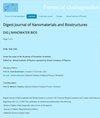Synthesis of Mn doped nanostructured zinc oxide thin films for H2 gas sensing
IF 1
4区 材料科学
Q4 MATERIALS SCIENCE, MULTIDISCIPLINARY
Digest Journal of Nanomaterials and Biostructures
Pub Date : 2024-06-06
DOI:10.15251/djnb.2024.192.793
引用次数: 0
Abstract
Thin films of zinc oxide and (ZnO:Mn) with 1% and 3% concentrations were created at 400 °C by spray pyrolysis. According to X-ray diffraction (XRD) investigation, ZnO films are polycrystalline and have a cubic structure with a distinct peak in one direction (101). The grain size increases as manganese content rise, from 12.66 nm to 14.66 nm. While the strain (ε) for ZnO reduced after manganese doping, it decreased from 27.36 to 23.63. Surface topography and nanostructure study reveal that as the manganese (Mn) content of ZnO films increased, cluster grain size, average roughness, and root mean square roughness (Rrms) all significantly reduced. SEM images show substantial morphological changes from flat islands to spherical nano-grains post-manganese via Mn content. The average transmittance was >70% in the visible area for Undoped ZnO and 1, 3% Manganese doping optical transmittance demonstrates exceptional optical transparency. When doping levels are increased by 1% or 3%, the absorption coefficient rises. The optical band gap widens in ZnO: Mn film for allowed direct transition has been decreased from (3.32 to 3.21) eV. Results illustrate that the films' refractive index and extinction coefficient decreases with increasing Mn Doped. Hydrogen gas decreases resistance in ZnO films, suggesting p-type behavior. Doping with 3% Mn increases resistance. Decreased sensitivity with higher Mn content after hydrogen gas exposure indicates increased electrical resistance in the film.用于 H2 气体传感的掺锰纳米结构氧化锌薄膜的合成
通过喷雾热解法,在 400 °C 下生成了浓度分别为 1% 和 3% 的氧化锌薄膜和(ZnO:Mn)薄膜。根据 X 射线衍射(XRD)研究,氧化锌薄膜为多晶体,具有立方结构,在一个方向上有明显的峰值(101)。晶粒尺寸随着锰含量的增加而增大,从 12.66 nm 增大到 14.66 nm。掺入锰后,氧化锌的应变(ε)减小,从 27.36 减小到 23.63。表面形貌和纳米结构研究表明,随着氧化锌薄膜中锰(Mn)含量的增加,晶簇粒度、平均粗糙度和均方根粗糙度(Rrms)都显著降低。扫描电子显微镜图像显示,锰含量增加后,纳米晶粒的形态发生了很大变化,从扁平的岛屿变成了球形。未掺杂 ZnO 在可见光区域的平均透射率大于 70%,而掺杂 1% 和 3% 锰的光学透射率则显示出卓越的光学透明度。当掺杂水平增加 1% 或 3% 时,吸收系数会上升。氧化锌的光带隙变宽:锰薄膜中允许直接转变的光带隙从 3.32 eV 减小到 3.21 eV。结果表明,薄膜的折射率和消光系数随着锰掺量的增加而降低。氢气降低了氧化锌薄膜的电阻,表明其具有 p 型行为。掺杂 3% 的锰会增加电阻。氢气暴露后,锰含量越高,灵敏度越低,这表明薄膜的电阻增加。
本文章由计算机程序翻译,如有差异,请以英文原文为准。
求助全文
约1分钟内获得全文
求助全文
来源期刊

Digest Journal of Nanomaterials and Biostructures
工程技术-材料科学:综合
CiteScore
1.50
自引率
22.20%
发文量
116
审稿时长
4.3 months
期刊介绍:
Under the aegis of the Academy of Romanian Scientists
Edited by: -Virtual Institute of Physics operated by Virtual Company of Physics.
 求助内容:
求助内容: 应助结果提醒方式:
应助结果提醒方式:


